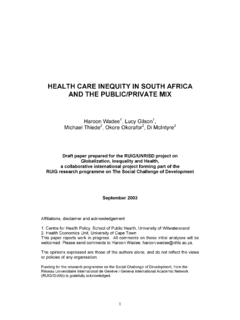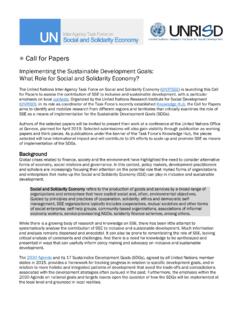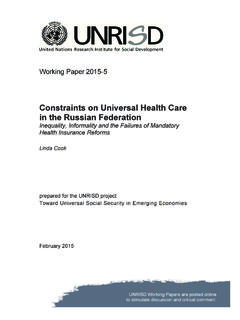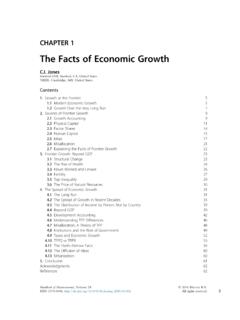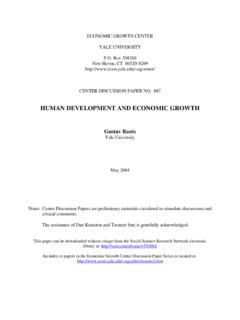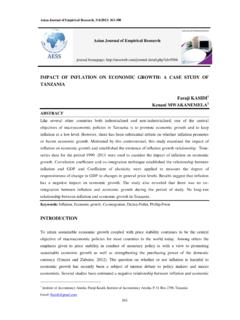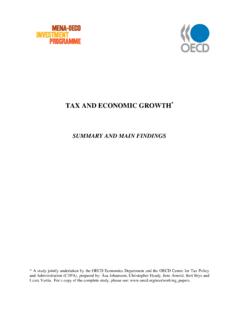Transcription of China’s Growth Miracle: Past, Present, and Future
1 China's Growth Miracle: Past, Present, and Future Li Yang1. Over the past 35 years, China has achieved extraordinary economic performance thanks to the market-oriented reforms and opening-up. By the end of 2012, China became the second largest economy by GDP size (nominal and PPP terms) just after the United States; The GDP per capita also reached to $6075 in 2012, up from $205 in 1980; Regarding the openness, as the largest exporter and second largest importer, China has accumulated $ trillion in foreign exchange reserves, ranked top in the world.
2 Meanwhile, China has been remaining the largest recipient of Foreign Direct investment (FDI). among the developing countries for the last two decades and more recently, came to become the exporting country judged by the outwards FDI. Nowadays, as a major driver of the global Growth , the incremental contribution of China has surpassed that of the All the above phenomena can be undoubtedly summarized as China's Growth 1. Growth performance of China's economy Figure 1: GDP based on 1990 International GK dollar, share of world total (%).
3 Notes: 1. Data come from Maddison historical GDP data: 2. The international GK dollar, sometimes known as the international dollar, is a hypothetical unit of currency that has the same purchasing power parity that the dollar had in the United States at a given point in time (eg. 1990). 1. Vice President, academic member and professor of the Chinese Academy of Social Sciences (CASS). 1. As can be seen in Figure 1, from AD 1 to the middle of 19th century, China' share of world GDP remained about 25%, exceeding that of Western European countries.
4 In particular, around 1820, this share rose to 33%, a record high level over the past two millenniums. Nevertheless, China's economy had long stagnated since then, resulting in a decline of its relative GDP size vis- -vis the world and a record low level, , in 1950. Subsequently after three decades of drastic economic fluctuations, around 1980, China started rapid economic Growth , resulting in the rise of its GDP. share of the world total, from in 1980 to in 2008. Figure 2: GDP based on PPP, share of world total (%). Notes: 1.
5 Data come from World economic Outlook Database, April 2013, IMF. 2. According to the figure, in 2013, the emerging and developing economies' share of world GDP will for the first time exceed that of advanced economies. Figure 3: China's contribution to world GDP Growth (%). 2. Notes: 1. Data come from World Development Indicators, April 2013, World Bank. 2. Left hand coordinate: GDP Growth rate of the World , World excluding China , and China ; right hand coordinate: China's contribution which equals the difference of the GDP Growth rate of the World and that of World excluding China.
6 As illustrated in Figure 3, from the 1978, China's GDP grew faster than that of the world total, without exception. It means that the contribution of China to the world GDP Growth remains positive, and tends to be increasingly important since the 1990s. For instance, in 2011, the Growth rate of world economy is , of which is due to China. Figure 4: Catch-up of GDP per capita (1990 Int. GK $): US =100. Notes: 1. Data come from Updated Maddison historical GDP data: 2. As defined by Woo (2012), once the GDP per capita of a country falls into the range of 20% to 55% of that of the US, it can be viewed as a middle-income economy.
7 Actually, in 2008, China's GDP per capita reached to of that of the US, and thus listed in the middle- income economy. In addition, China overtook India in 1978, and the world average in 2009 in terms of GDP per capita. Over the past three decades, China's Growth miracle can be viewed as the most impressive, lasting, and complex in terms of institutional changes and constraint conditions in the human history of economic Growth , which is generally praised by both prestigious international organizations and economists. However, it should be stressed that such miracle is by no means costless.
8 It is highly needed to reexamine the characteristics of China's Growth based on the experiences of the last 30 years, and to promote the transformation of Growth mode towards a well balanced and sustainable development path. 3. 1. Main factors determining China's economic Growth China's Growth miracle has been intensively discussed abroad and at home. We will consider the four main factors as follows: (1) Gradual economic reforms. The intrinsic character of the gradualism strategy is to incrementally introduce the market institutions without drastically damaging the vested interests.
9 During the process, the forces of the market permeate the traditional planning system through the effects of trickle-down'. At the 14th CPC National Congress held in October 1992, the goal of the economic reforms has been set to establish a socialist market economic system. At the Third Plenary Session of the 14th CPC National Congress, the overall planning of the further market-oriented reforms has been launched. From 1991 onwards, six fields of reforms of great importance have been performed along this strategy. a. Fiscal reforms.
10 In the history of China, for the first time we introduce the de facto fiscal federalism under the principle of expenditure- revenue matching, which is mainly characterized by a system including central taxes, local taxes, and central- local sharing taxes. b. Reforms in financial sector. Before 1978, as the only bank in China, the People's Bank of China (PBC) was playing two roles at the same time, the central bank and a business bank. From 1978 onwards, after three waves of reform, the PBC has been turned into a sole monetary authority whose duties are to set and carry out monetary policies.




